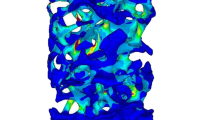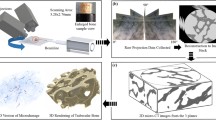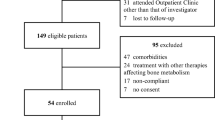Abstract
Summary
The effects of a 3-year alendronate treatment on trabecular stresses/strains associated with microdamage initiation were investigated using finite element modeling (FEM). Severely damaged trabeculae in the low-dose treatment group were associated with increased stresses compared with the high-dose treatment group (p = 0.006) and approached significance in the control group (p = 0.02).
Introduction
Alendronate, a commonly prescribed anti-remodeling agent, decreases fracture risk in the vertebrae, hip, and wrist of osteoporotic individuals. However, evaluation of microdamage accumulation in animal and human studies shows increased microdamage density relative to controls. Microstructural von Mises stresses associated with severe and linear damage have been found to decrease after 1 year of alendronate treatment. In the present study, stresses/strains associated with damage were assessed after 3 years of treatment to determine whether they continued to decrease with increased treatment duration.
Methods
Microdamaged trabeculae visualized with fluorescent microscopy were associated with stresses and strains obtained using image-based FEM. Stresses/strains associated with severe, diffuse, and linearly damaged and undamaged trabeculae were compared among groups treated for 3 years with an osteoporotic treatment dose of alendronate, a Paget’s disease treatment dose of alendronate, or saline control. Architectural characteristics and mineralization were also analyzed from three-dimensional microcomputed tomography reconstructed images.
Results
Severely damaged trabeculae in the osteoporotic treatment dose group were associated with increased stress compared with the Paget’s disease treatment dose group (p = 0.006) and approached significance compared to the control group (p = 0.02). Trabecular mineralization in severely damaged trabeculae of the low-dose treatment group was significantly greater compared to severely damaged trabeculae in the high-dose treatment and control group, suggesting that changes at the tissue level may play a role in these findings.
Conclusions
Trabecular level stresses associated with microdamage do not continue to decrease with prolonged alendronate treatment. Changes in mineralization may account for these findings.




Similar content being viewed by others
References
Black DM, Cummings SR, Karpf DB, Cauley JA, Thompson DE, Nevitt MC, Bauer DC, Genant HK, Haskell WL, Marcus R, Ott SM, Torner JC, Quandt SA, Reiss TF, Ensrud KE (1996) Randomised trial of effect of alendronate on risk of fracture in women with existing vertebral fractures. Fracture intervention trial research group. Lancet 348(9041):1535–1541
Black DM, Thompson DE, Bauer DC, Ensrud K, Musliner T, Hochberg MC, Nevitt MC, Suryawanshi S, Cummings SR (2000) Fracture risk reduction with alendronate in women with osteoporosis: the fracture intervention trial. FIT research group. J Clin Endocrinol Metab 85(11):4118–4124
Rodan GA, Reszka AA (2002) Bisphosphonate mechanism of action. Curr Mol Med 2(6):571–577
Allen MR, Burr DB (2007) Mineralization, microdamage, and matrix: how bisphosphonates influence material properties of bone. Bone Key Osteovision 4(2):49–60
Tang SY, Allen MR, Phipps R, Burr DB, Vashishth D (2009) Changes in non-enzymatic glycation and its association with altered mechanical properties following 1-year treatment with risedronate or alendronate. Osteoporos Int 20(6):887–894
Allen MR, Iwata K, Phipps R, Burr DB (2006) Alterations in canine vertebral bone turnover, microdamage accumulation, and biomechanical properties following 1-year treatment with clinical treatment doses of risedronate or alendronate. Bone 39(4):872–879
Stepan JJ, Burr DB, Pavo I, Sipos A, Michalska D, Li J, Fahrleitner-Pammer A, Petto H, Westmore M, Michalsky D, Sato M, Dobnig H (2007) Low bone mineral density is associated with bone microdamage accumulation in postmenopausal women with osteoporosis. Bone 41(3):378–385
Mashiba T, Hirano T, Turner CH, Forwood MR, Johnston CC, Burr DB (2000) Suppressed bone turnover by bisphosphonates increases microdamage accumulation and reduces some biomechanical properties in dog rib. J Bone Miner Res 15(4):613–620
Schaffler MB, Radin EL, Burr DB (1989) Mechanical and morphological effects of strain rate on fatigue of compact bone. Bone 10(3):207–214
Ruppel ME, Burr DB, Miller LM (2006) Chemical makeup of microdamaged bone differs from undamaged bone. Bone 39(2):318–324
Shane E, Burr D, Ebeling PR, Abrahamsen B, Adler RA, Brown TD, Cheung AM, Cosman F, Curtis JR, Dell R, Dempster D, Einhorn TA, Genant HK, Geusens P, Klaushofer K, Koval K, Lane JM, McKiernan F, McKinney R, Ng A, Nieves J, O'Keefe R, Papapoulos S, Sen HT, van der Meulen MC, Weinstein RS, Whyte M (2010) American Society for Bone and Mineral Research. J Bone Miner Res 25(11):2267–2294
Yeni YN, Zelman EA, Divine GW, Kim DG, Fyhrie DP (2008) Trabecular shear stress amplification and variability in human vertebral cancellous bone: relationship with age, gender, spine level and trabecular architecture. Bone 42(3):591–596
Fyhrie DP, Hoshaw SJ, Hamid MS, Hou FJ (2000) Shear stress distribution in the trabeculae of human vertebral bone. Ann Biomed Eng 28(10):1194–1199
Nagaraja S, Couse TL, Guldberg RE (2005) Trabecular bone microdamage and microstructural stresses under uniaxial compression. J Biomech 38(4):707–716
O'Neal JM, Diab T, Allen MR, Vidakovic B, Burr DB, Guldberg RE (2010) One year of alendronate treatment lowers microstructural stresses associated with trabecular microdamage initiation. Bone 47(2):241–247
Allen MR, Burr DB (2007) Three years of alendronate treatment results in similar levels of vertebral microdamage as after one year of treatment. J Bone Miner Res 22(11):1759–1765
Keaveny TM, Pinilla TP, Crawford RP, Kopperdahl DL, Lou A (1997) Systematic and random errors in compression testing of trabecular bone. J Orthop Res 15(1):101–110
O'Brien FJ, Taylor D, Lee TC (2002) An improved labelling technique for monitoring microcrack growth in compact bone. J Biomech 35(4):523–526
Moore ATL, Gibson LJ (2002) Microdamage accumulation in bovine trabecular bone in uniaxial compression. J Biomech Eng 124(1):63–71
van Rietbergen B, Weinans H, Huiskes R (1996) Computational strategies for iterative solutions of large FEM applications employing voxel data. Int J Numer Methods Eng 39:2743–2767
van Rietbergen B, Weinans H (1995) Huiskes R, Odgaard A, A new method to determine trabecular bone elastic properties and loading using micromechanical finite-element models. J Biomech 28(1):69–81
Boivin G, Meunier PJ (2002) Effects of bisphosphonates on matrix mineralization. J Musculoskelet Neuronal Interact 2(6):538–543
Shi X, Liu XS, Wang X, Guo XE, Niebur GL (2010) Effects of trabecular type and orientation on microdamage susceptibility in trabecular bone. Bone 46(5):1260–1266
Arlot ME, Burt-Pichat B, Roux J-P, Vashishth D, Bouxsein ML, Delmas PD (2008) Microarchitecture influences microdamage accumulation in human vertebral trabecular bone. J Bone Miner Res 23(10):1613–1618
Allen MR, Reinwald S, Burr DB (2008) Alendronate reduces bone toughness of ribs without significantly increasing microdamage accumulation in dogs following 3 years of daily treatment. Calcif Tissue Int 82(5):354–360
Allen MR, Gineyts E, Leeming DJ, Burr DB, Delmas PD (2008) Bisphosphonates alter trabecular bone collagen cross-linking and isomerization in beagle dog vertebra. Osteoporos Int 19(3):329–337
Acknowledgements
This study was supported by NIH grants 5R01AG027249, 5R01AR047838, and 5T32AR007581. Merck kindly provided the alendronate. The micro-CT system was provided by an NSF Major Research Instrumentation Award (9977551).
Conflicts of interest
Dr. Burr receives grant/research support from Eli Lilly, Procter and Gamble Pharmaceuticals, The Alliance for Better Bone Health, Pfizer, and NephroGenex. He is a consultant/scientific advisor for Eli Lilly, Procter and Gamble Pharmaceuticals, Amgen, and PharmaLegacy. He is a speaker for Amgen and Eli Lilly. The other authors have no conflicts of interest.
Author information
Authors and Affiliations
Corresponding author
Rights and permissions
About this article
Cite this article
Green, J.O., Diab, T., Allen, M.R. et al. Three years of alendronate treatment does not continue to decrease microstructural stresses and strains associated with trabecular microdamage initiation beyond those at 1 year. Osteoporos Int 23, 2313–2320 (2012). https://doi.org/10.1007/s00198-011-1875-8
Received:
Accepted:
Published:
Issue Date:
DOI: https://doi.org/10.1007/s00198-011-1875-8




